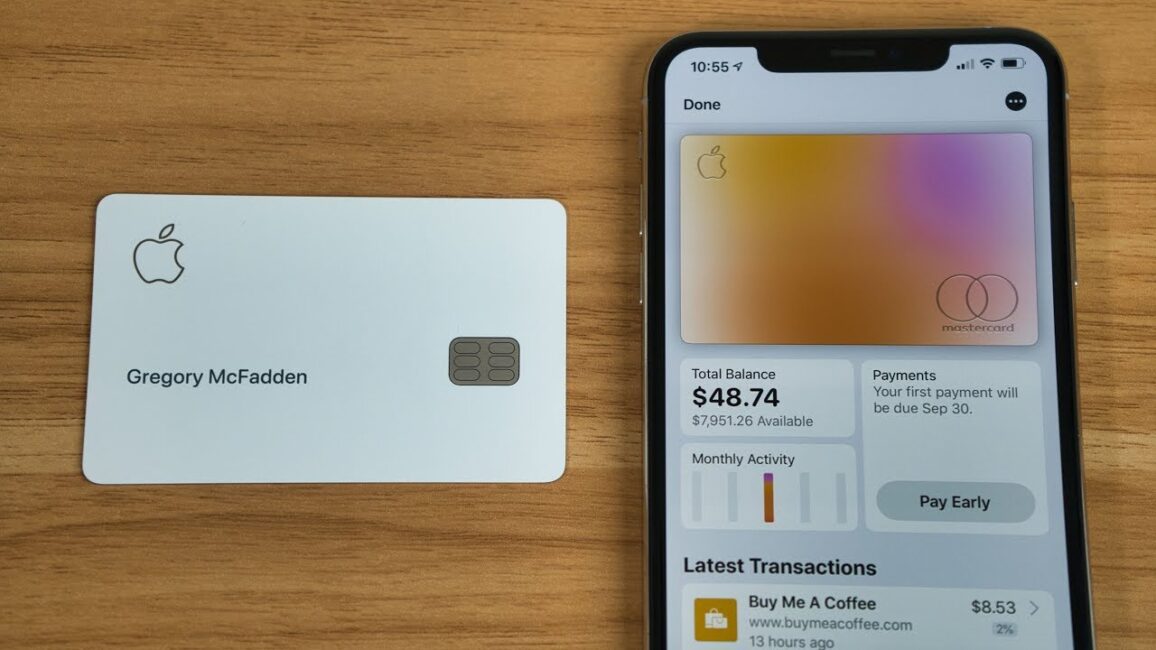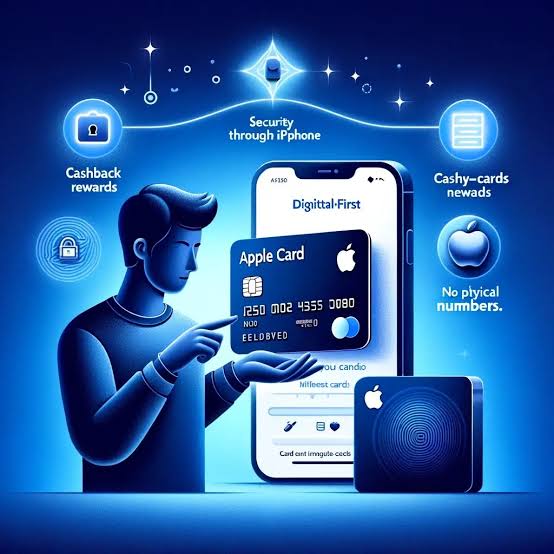The Apple Card is a credit card designed by Apple in partnership with Goldman Sachs and Mastercard, launched with a focus on user-friendly features, high security, and transparency. Unlike traditional credit cards, the Apple Card integrates seamlessly with Apple’s ecosystem, offering a digital-first experience via the Wallet app on iPhones.
Its distinct design, transparency in terms and rewards, and emphasis on privacy make it an appealing option in the competitive world of credit cards. Understanding its features and benefits reveals the innovation Apple has brought to personal finance management.
One of the defining aspects of the Apple Card is its easy application process. Through the Wallet app on the iPhone, users can apply for the card with just a few steps, making it accessible to Apple users without the need for paperwork or visits to a bank.
Once approved, the digital card appears in the Wallet app, ready for use instantly, allowing users to start spending before they even receive the physical card. This process is efficient and aligns with Apple’s mission of streamlining technology.
The Apple Card also stands out in its integration with the iPhone and Wallet app, where cardholders can easily manage their accounts. Within the app, users have access to all their transactions, spending summaries, and statements.
The Wallet app groups purchases into categories such as food, entertainment, and travel, presenting color-coded summaries that offer a visual understanding of spending patterns. X xThis makes financial management intuitive, allowing cardholders to set spending limits, track trends, and make adjustments based on real-time insights.
Furthermore, with no traditional paper statements and the entire system being digital, the Apple Card reduces the need for mailing services, which can also be seen as an environmentally friendly approach. The rewards system offered by the Apple Card is both unique and valuable.
Through its Daily Cash program, cardholders earn cash back on purchases, which is credited directly to their Apple Cash account every day rather than waiting for the end of a billing cycle. This immediate cash back is usable for future purchases or can be transferred to a bank account.
Apple offers three main tiers of rewards: three percent cash back on purchases made directly with Apple or selected partners, two percent on transactions made using Apple Pay, and one percent on purchases made with the physical Apple Card.
This rewards system encourages the use of Apple Pay, Apple’s secure and convenient payment method, and aligns well with Apple’s digital-first approach. Security and privacy are central to the Apple Card, which uses multiple layers of protection to safeguard user data.
The digital Apple Card employs Face ID or Touch ID for authorization, ensuring only the cardholder can make purchases. Each transaction requires a unique, one-time dynamic security code, adding an additional layer of security against fraud.
Apple also prioritizes user privacy by not storing transaction histories on its servers, so spending data is never shared or sold for marketing purposes. This level of privacy contrasts with many traditional banks and credit card providers, offering reassurance to users concerned with data privacy.
The physical Apple Card, while secondary to the digital version, is distinct in its design and functionality. Made from titanium and laser-etched with the cardholder’s name, the card is simple and minimalist, with no visible card number, CVV code, or expiration date.
This minimalist design enhances security since card details are stored in the Wallet app rather than printed on the card.
The lack of visible information reduces the risk of data theft from the card itself, as it cannot easily be copied. Instead, all necessary details for online or non-Apple Pay transactions are accessible securely within the app, which adds a new level of protection and modern elegance.
In terms of fees, the Apple Card was designed with transparency and fairness in mind. It has no annual fees, no international transaction fees, and no late payment fees, making it accessible to those who prefer to avoid the typical costs associated with many other credit cards.
The card’s interest rates are displayed in a clear manner within the Wallet app, so cardholders know exactly how much they owe without hidden or confusing terms.
Moreover, the Wallet app allows users to visualize their interest costs based on payment amounts, helping them make informed financial decisions. This emphasis on transparency aligns with Apple’s commitment to providing users with control over their finances.
The Apple Card also offers valuable support for managing credit and debt. Unlike traditional cards that charge late fees, the Apple Card does not penalize missed payments with fees, though interest still accrues on balances.
This approach encourages responsible financial habits without punitive charges. The Wallet app helps cardholders manage balances by providing payment options and estimating interest charges for partial payments, which supports users in paying down balances over time.
For users new to credit or concerned with maintaining a good credit score, these tools provide guidance in managing balances effectively and building a solid credit history.
An additional innovative feature of the Apple Card is its Family Sharing option, allowing families to share one Apple Card account among members. Parents can add children as authorized users, enabling them to build credit under parental guidance.
Family members can view and monitor spending, set limits for each user, and track expenses collectively. This feature offers flexibility and transparency in managing family finances and promotes responsible financial habits for younger users.
The Family Sharing option reflects Apple’s approach of blending technology and family life, making financial management inclusive and educational
How to Apply and Manage Your Apple Card

Applying for and managing the Apple Card combines the convenience of a digital-first approach with Apple’s commitment to privacy, security, and simplicity. The process to apply and use the card is designed to be efficient and accessible, empowering users to handle their finances within the familiar Apple ecosystem.
1. Checking Eligibility Requirements: Before applying, ensure you meet the Apple Card’s eligibility requirements. Applicants must be at least 18 years old, have an Apple ID linked to iCloud, and possess an iPhone running iOS 12.4 or later.
Apple may also evaluate credit history and other financial factors during the application process. As the Apple Card operates in partnership with Goldman Sachs, it adheres to the financial standards set forth by this institution, which includes an evaluation of the applicant’s creditworthiness.
2. Applying for the Apple Card: To apply, open the Wallet app on your iPhone and select “Add Card.” From here, choose “Apple Card” and follow the instructions provided.
The application process will prompt you to enter personal details, such as your full name, address, date of birth, income, and social security number. Apple and Goldman Sachs review this information to determine eligibility and offer an initial credit limit.
Once approved, you can accept the terms and conditions, after which the digital Apple Card will immediately appear in your Wallet app, ready for use. This streamlined process allows new cardholders to start using their Apple Card within minutes of approval.
3. Understanding the Apple Card’s Rewards Structure: Apple Card offers a unique Daily Cash rewards program, providing cashback on eligible purchases. Cardholders earn three percent cash back on purchases made with Apple and selected partners, two percent on transactions made via Apple Pay, and one percent on purchases made with the physical Apple Card.
The rewards earned are credited as Daily Cash, which can be used for future purchases, transferred to a bank account, or sent to Apple Cash. These daily rewards encourage the use of Apple Pay, aligning with Apple’s ecosystem while offering valuable cashback benefits for users.
4. Setting Up Apple Cash for Daily Cash Rewards: Apple Cash is required to receive Daily Cash rewards from the Apple Card. Setting up Apple Cash is straightforward. Open the Wallet app, tap on Apple Cash, and follow the prompts to activate it if it is not already set up.
With Apple Cash enabled, Daily Cash rewards automatically accumulate each day and appear as an available balance. This balance can be spent on purchases through Apple Pay, transferred to a bank account, or saved in the Wallet app, giving users flexibility in how they use their earned rewards.
5. Using the Apple Card Digitally with Apple Pay: Apple Card is designed to be a digital-first credit card, prioritizing the use of Apple Pay. With Apple Pay, users can make secure, contactless payments at participating retailers.
To make a payment, open the Wallet app, select Apple Card, and hold the iPhone near a contactless reader while authenticating with Face ID or Touch ID. This integration allows for a quick and secure transaction process, enhancing user convenience and minimizing the need for physical card use.
6. Managing Your Apple Card Account in the Wallet App: Apple Card’s management features are seamlessly integrated within the Wallet app, where users can monitor transactions, view balances, and access statements.
The app categorizes spending, presenting color-coded summaries that help users visualize and understand spending habits. Monthly summaries are available, giving cardholders an overview of their financial activity and assisting in tracking expenses over time.
Users can also view specific transaction details, including location and merchant, which adds a layer of transparency and helps with expense management.
7. Making Payments on Your Apple Card Balance: Paying the Apple Card balance is also managed directly within the Wallet app. Open the app, select Apple Card, and choose the “Pay” option. The app allows users to make either full or partial payments.
Apple provides a visual indicator that shows the amount of interest that will accrue based on the payment amount selected, helping cardholders make informed decisions about their payments. Payments can be made manually or scheduled as recurring payments to simplify the process.
8. Setting Spending Limits and Budgeting with the Apple Card: Through the Wallet app, users can set personal spending limits, offering a tool for better financial discipline. By using spending summaries and tracking features, Apple Card holders can monitor their budget more closely, helping to avoid overspending and manage finances in a structured way.
Spending categories like food, entertainment, and travel are easy to monitor, enabling a clear understanding of where funds are allocated each month.
9. Understanding and Managing Apple Card Fees: Apple Card stands out for its transparency in fees, with no annual fees, international transaction fees, or late payment fees.
However, interest charges will apply on unpaid balances, and the Wallet app displays these charges in a clear manner, allowing users to see exactly how much interest will accrue based on payment choices. This fee transparency empowers cardholders to stay informed and make responsible financial choices.
10. Using Apple Card Family Sharing: Apple Card Family Sharing allows account holders to share their Apple Card with family members. By setting spending limits and sharing access, the main cardholder can help family members develop financial responsibility.
This feature is beneficial for households that want to collectively manage their finances while providing younger users with a secure and monitored credit experience. Apple Card Family Sharing also allows parents to view and control their children’s spending activity.
11. Maximizing Security Features: Apple places high importance on security with the Apple Card, integrating Face ID, Touch ID, and a unique security code for each transaction. The card number is stored securely in the Wallet app and is not printed on the physical card, reducing the risk of unauthorized use.
These security measures make the Apple Card one of the most secure options for users concerned with protecting personal data and financial information.
12. Contacting Apple Card Support: Apple Card support is easily accessible through the Wallet app. Users can contact support by messaging Apple directly within the app, where representatives provide assistance on topics ranging from account inquiries to transaction issues.
This in-app support ensures that users have quick access to help whenever it is needed, reinforcing Apple’s focus on convenience.
13. Tracking Credit Score Impact and Building Credit: Apple Card reports to major credit bureaus, which means responsible usage can positively impact one’s credit score over time.
Timely payments, maintaining a low balance, and monitoring spending can all contribute to buiaalding or maintaining good credit. The Wallet app provides tools and reminders that help users stay on top of payments, further supporting their journey in building financial health.
Pros and Cons of the Apple Card

The Apple Card has gained attention for its user-centric design, emphasis on privacy, and seamless integration within the Apple ecosystem. While it brings notable benefits, it also has limitations that prospective users should consider.
Read Also: Where to Find the Best Whole Foods Products Near Me
Pros
1. Simple Application and Quick Access:
Applying for the card is a straightforward process completed through the iPhone’s Wallet app. Once approved, users can access the digital card immediately, allowing for same-day use through Apple Pay.
This speed and convenience reduce the need for physical paperwork or lengthy approval times, a notable advantage in comparison to traditional credit cards.
2. Seamless Integration with the Apple Ecosystem: The Apple Card integrates with Apple Pay and the Wallet app, enabling users to make payments, track spending, and view rewards without leaving their Apple device. For those who are already engaged with Apple products, this integration simplifies financial management and enhances the usability of other Apple services, creating a cohesive digital experience.
3. Daily Cash Rewards: Apple offers a unique rewards structure with its Daily Cash program, granting cashback on eligible purchases every day rather than monthly.
Cardholders earn three percent on purchases with Apple and selected partners, two percent on Apple Pay transactions, and one percent on purchases made with the physical card. The rewards, credited as Daily Cash, provide an incentive to use Apple Pay and deliver flexibility for immediate spending, transferring, or saving.
4. No Fees for Essential Transactions: The Apple Card has no annual, late payment, foreign transaction, or over-limit fees. This fee-free approach offers transparency and cost savings, especially for those who travel internationally or might occasionally miss a payment.
Although interest charges apply on unpaid balances, Apple’s commitment to eliminating many traditional credit card fees sets it apart as a low-cost option for users.
5. Enhanced Security and Privacy Measures: Apple incorporates multiple layers of security, including Face ID, Touch ID, and a unique transaction code for each payment. The physical card itself lacks a printed number, reducing the risk of unauthorized use.
Furthermore, Apple does not collect transaction details, which ensures privacy for the cardholder and protects their personal and financial information from potential misuse.
6. User-Friendly Financial Tracking: Through the Wallet app, the card offers spending summaries and color-coded categories to help users manage and understand their expenses.
Monthly spending reports and transaction histories promote responsible financial habits, assisting cardholders in visualizing where funds are spent. This transparency fosters budgeting discipline and offers insight for users aiming to better control their spending.
7. Support for Family Sharing: The Apple Card includes a Family Sharing feature, allowing cardholders to share their account with family members while setting spending limits for each individual.
This feature offers a controlled environment for family finances and supports younger users in learning responsible credit habits under the supervision of an adult cardholder.
8. Opportunity for Credit Building: As Apple Card reports to major credit bureaus, responsible use can positively impact a cardholder’s credit score.
Regular, on-time payments and maintaining a low balance contribute to building or strengthening credit, making the card a potential option for those looking to improve their financial profile.
Read Also: The Comprehensive Guide to Office Depot: Your One-Stop Shop for Office Supplies
Cons
1. Exclusive to Apple Devices: The card is only accessible to users with compatible Apple devices running iOS 12.4 or later. Those using other smartphones or non-Apple devices cannot apply for or use the Apple Card, making it impractical for individuals outside of the Apple ecosystem.
This limitation excludes a significant portion of potential users who may otherwise be interested in its features and benefits.
2. Limited Acceptance of the Physical Card: While the card functions digitally via Apple Pay, certain merchants do not accept Apple Pay, and international acceptance of the physical titanium card may be inconsistent.
The limited acceptance of both the digital and physical versions of the card could result in inconvenience, especially for those traveling to areas where contactless payments or Apple Pay are not widely supported.
3. Lower Rewards for Physical Card Purchases: Although the Daily Cash rewards program is beneficial, the reward rate drops to one percent when using the physical card rather than Apple Pay.
This reduced rate can impact cardholders who frequently shop at locations that do not accept Apple Pay. As a result, users may find the rewards less appealing when shopping outside Apple’s digital payment infrastructure.
4. No Introductory 0% APR Offer: Unlike some other credit cards, the Apple Card does not offer an introductory 0% APR period on purchases or balance transfers.
This omission may be a disadvantage for those looking to finance a large purchase interest-free or transfer a balance from another card. The lack of an introductory APR period limits its appeal as a financial tool for short-term, interest-free financing.
5. Limited Travel and Purchase Protection: Many traditional credit cards include comprehensive travel insurance and purchase protection, covering areas such as trip cancellations, lost baggage, or product warranties.
The Apple Card, however, does not offer extensive travel or purchase protection benefits. This shortfall may deter frequent travelers or those who value extended purchase coverage in their credit card options.
6. Interest Charges on Unpaid Balances: Although there are no late payment fees, interest charges do accrue on unpaid balances. The Wallet app provides a visual indicator of how much interest will accrue based on the payment amount selected, which is useful for tracking costs but may be limiting for users who rely on the card without fully paying the balance each month. Carrying a balance can lead to higher long-term costs due to these interest charges.
7. Limited Redemption Options for Daily Cash Rewards: Daily Cash is credited to Apple Cash and can be used for purchases, transferred to a bank account, or sent to friends via Apple Cash.
However, compared to other rewards programs that may offer travel points or redemption for specific experiences, Daily Cash’s redemption options are more restricted. Users seeking diverse redemption methods may find these limited choices less versatile for their lifestyle.
8. Restrictions on International Cardholders: The Apple Card is currently only available to U.S. citizens and residents. For international Apple users, the lack of availability limits the card’s reach, excluding those outside the United States who may otherwise wish to use it.
This geographic restriction restricts global adoption and affects users who frequently travel between the U.S. and other regions.
Frequently Asked Questions on How to Apply and Manage Your Apple Card

1. Who is eligible for the Apple Card?
To be eligible for the Apple Card, you must be at least 18 years old (19 in some states) and a U.S. citizen or lawful resident with a valid U.S. address.
You must also have an Apple device compatible with the Wallet app, such as an iPhone running iOS 12.4 or later. Additionally, approval for the card depends on your creditworthiness, which includes factors such as credit score, payment history, and income.
2. How do I apply for the Apple Card?
Applying for the Apple Card is a streamlined process completed entirely on your iPhone. To apply, open the Wallet app, tap the “+” icon, and select “Apple Card.” You will be asked to provide some personal information, including your full name, date of birth, address, income, and last four digits of your Social Security number.
Once submitted, Goldman Sachs, the card’s issuing bank, will review your application. If approved, you’ll receive your credit limit and APR immediately, and the card will be added to your Wallet app for immediate use with Apple Pay.
3. How can I manage my Apple Card payments?
You can manage payments easily through the Wallet app, where you’ll see a breakdown of your current balance, spending by category, and minimum payment required. Payments can be made directly through the app, allowing you to schedule a one-time payment or set up recurring payments.
The app provides a real-time interest calculator that shows how much interest will accrue based on the payment amount you choose. Paying off your balance in full each month avoids interest charges.
4. How does the Daily Cash rewards program work?
The Apple Card’s Daily Cash rewards program provides cashback on eligible purchases, credited daily. Purchases made with Apple Pay receive two percent back, purchases directly from Apple (such as in-store, online, or through App Store purchases) earn three percent, and transactions with the physical card earn one percent.
Rewards are added to your Apple Cash card, which can be used for purchases, transferred to a bank account, or sent to others via Apple Cash. Unlike many other credit cards, the Apple Card does not require waiting until the end of the billing cycle for rewards to be available.
5. What security features does the Apple Card offer?
Apple places a high emphasis on security, ensuring transactions are secure and private. When using the Apple Card with Apple Pay, each transaction is authorized with Face ID, Touch ID, or a passcode and a unique, one-time dynamic security code. Additionally, Apple does not store or track transaction data, ensuring that purchase history remains private.
The physical titanium card itself does not display a card number, expiration date, or CVV code, making it more secure than traditional credit cards. For online purchases, a virtual card number is available in the Wallet app and can be regenerated for enhanced security.
6. How can I view and track my spending?
The Wallet app offers an intuitive overview of your spending habits, organizing purchases by category, such as food, shopping, and entertainment. Transactions are color-coded for easy reference, and you can view both weekly and monthly summaries.
This detailed insight helps users understand their spending patterns, aiding in budgeting and financial management. The app also provides payment reminders and notifications, helping users stay on track with payments and avoid unnecessary interest charges.
7. What should I do if I lose my physical Apple Card?
If you lose your physical titanium Apple Card, you can lock it directly from the Wallet app to prevent unauthorized use. The app also allows you to request a replacement card at no additional cost.
Since the Apple Card can be used digitally through Apple Pay, losing the physical card does not affect your ability to make purchases in most cases, as long as the merchant accepts Apple Pay. For online transactions, you can continue using the virtual card number generated within the Wallet app.
8. Can I share my Apple Card with family members?
Apple Card Family allows primary cardholders to share their card with up to five other individuals in their Family Sharing group, provided they are at least 13 years old. Family members receive their own card number, and spending limits can be set for each participant.
Transactions made by family members appear in the Wallet app, allowing the primary account holder to monitor spending and ensure accountability. Additionally, family members 18 years and older have the opportunity to build their credit history with shared responsibility for the account.
Read Also: Master of Business Administration on Healthcare Management
Do you have any questions, suggestions, or contributions? If so, please feel free to use the comment box below to share your thoughts. We also encourage you to kindly share this information with others who might benefit from it. Since we can’t reach everyone at once, we truly appreciate your help in spreading the word. Thank you so much for your support and for sharing!






